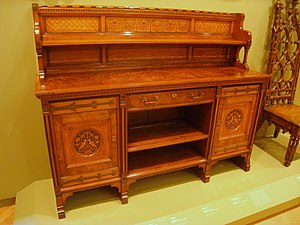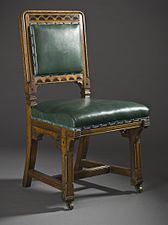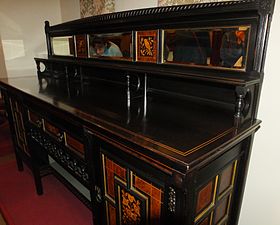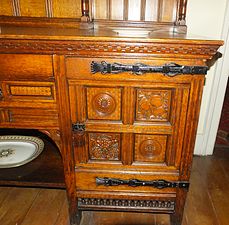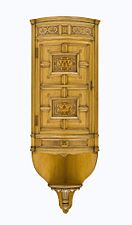Bruce James Talbert

Bruce James Talbert (1838 – 28 January 1881) was a Scottish architect, interior designer and author, best known for his furniture designs.
In the United States, he influenced the
Biography
He studied at the
He moved to London in 1866 to design furniture for Holland & Sons. The following year his
Talbert's first book, Gothic Forms Applied to Furniture, Metal Work and Decoration for Domestic Purposes, proved to be influential on the commercial production of furniture. He recommended framed construction, decorative inlay,
Talbert died at age 43 of alcoholism.[8][9]
His work is included in the collections of the Victoria and Albert Museum[10] and the Art Institute of Chicago.[11]
Publications
Gothic Forms Applied to Furniture, Metal Work, and Decoration for Domestic Purposes, was published in London in 1868, and in the United States in 1873. That was followed by Examples of Ancient & Modern Furniture, Metal Work, Tapestries, Decorations, published in London in 1876, and in the United States in 1877. His third book, Fashionable Furniture: A Collection of Three Hundred and Fifty Original Designs Representing Cabinet Work, Upholstery and Decoration (1881), was published posthumously.
-
Illustration from Gothic Forms Applied to Furniture, Metal Work, and Decoration for Domestic Purposes (1868).
-
Illustration from Examples of Ancient and Modern Furniture, Metal Work, Tapestries, Decorations (1876).
-
Illustration from The Cabinet Maker and Art Furnisher (1881).
Selected works
- Sleeping Beauty Sideboard (1867), manufactured by Holland & Sons, Victoria and Albert Museum, London.[12]
- Pet Sideboard (ca. 1871), manufactured by Gillow & Co., Victoria and Albert Museum, London.[13]
- Dundee Cabinet (ca. 1872), manufactured by Gillow & Co., Judges' Lodgings, Lancaster.
- Sideboard (ca. 1872), manufactured by Gillow & Co., Judges' Lodgings, Lancaster.
- Juno Cabinet (1878), manufactured by Jackson & Graham, Victoria and Albert Museum, London.[14] Won the Grand Prix at the 1878 Paris Exhibition.
Judges' Lodgings, Lancaster
Two
The second sideboard (ca. 1872), made of
-
Clock (ca. 1865), Indianapolis Museum of Art.
-
Sideboard (1867). Part of the display that won a silver medal at the 1867 Paris Exhibition.
-
Sideboard (1867), Carnegie Museum of Art.
-
Dining chair (ca. 1867), Los Angeles County Museum of Art.
-
Sideboard (ca. 1871), Art Institute of Chicago.
-
Dundee Cabinet (ca. 1872), Judges' Lodgings, Lancaster
-
Sideboard (ca. 1872), Judges' Lodgings, Lancaster
-
Hanging corner cabinet (ca. 1875), Los Angeles County Museum of Art.
Metropolitan Museum of Art, New York City
The Pericles dressoir was designed to be a part of the British exhibition at Paris International Exhibition in 1867. Its name comes from a play written by William Shakespeare, Pericles, Prince of Tyre. Some parts of the play are engraven into the furniture.[16]
-
Mantel clock (ca. 1870)
-
Sideboard known as the Pericles dressoir
-
Central panel of the Pericles dressoir
-
Woodwork on the Pericles dressoir
References
- ^ David Hanks, "Reform in Philadelphia: Frank Furness, Daniel Pabst, and 'Modern Gothic' Furniture," Art News, vol. 74, no. 8 (October 1975).
- ^ Cabinet, attributed to Daniel Pabst Archived 2 November 2013 at the Wayback Machine from Metropolitan Museum of Art.
- ^ "Dictionary of Scottish Architects - DSA Architect Biography Report (May 30, 2022, 6:59 pm)". Scottisharchitects.org.uk. Archived from the original on 19 January 2022. Retrieved 30 May 2022.
- ISBN 978-0-19-518948-3. Retrieved 30 May 2022 – via Google Books.
- ^ a b (Payne, p136)
- ^ (Payne, p137)
- ^ a b c Display panel, the Judges' Lodgings, Lancaster
- ^ "The Elmbridge Hundred - Bruce James Talbert". People.elmbridgehundred.org.uk. Archived from the original on 16 September 2021. Retrieved 30 May 2022.
- from the original on 30 May 2022. Retrieved 30 May 2022 – via JSTOR.
- ^ Museum, Victoria and Albert. "Sideboard | Talbert, Bruce James | V&A Explore The Collections". Victoria and Albert Museum: Explore the Collections. Archived from the original on 26 June 2022. Retrieved 13 January 2023.
- ^ Talbert, Bruce James. "Drawing Room Cabinet". The Art Institute of Chicago. Archived from the original on 6 July 2022. Retrieved 13 January 2023.
- ^ Sleeping Beauty Sideboard Archived 2 November 2013 at the Wayback Machine from Victoria and Albert Museum.
- ^ Pet Sideboard Archived 26 June 2022 at the Wayback Machine from Victoria and Albert Museum.
- ^ Juno Cabinet Archived 3 March 2016 at the Wayback Machine from Victoria and Albert Museum.
- ^ A History of Gillow of Lancaster, (Lancashire County Council, 1984)
- ^ "Sideboard, also known as the Pericles Dressoir : 1866". Metmuseum.org. Archived from the original on 15 August 2022. Retrieved 30 May 2022.
Bibliography
- Payne, Christopher, ed. (1989). Sotheby's concise encyclopedia of furniture (Reprint ed.). London: Conran Octopus. ISBN 9781850296492.
- Sally MacDonald, "Gothic Forms Applied to Furniture: The Early Work of Bruce James Talbert," Furniture History, vol. 23 (1987), pp. 39–66.
- Simon Jervis, "Charles, Bevan & Talbert," The Decorative Arts of the Victorian Period, ed. S. Wright (1989), pp. 15–29.






